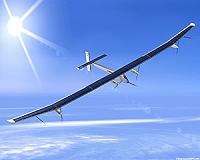|
 Purple Pokeberries Hold Secret To Affordable Solar Power Worldwide
Purple Pokeberries Hold Secret To Affordable Solar Power WorldwideWinston-Salem NC (SPX) May 03, 2010 Pokeberries - the weeds that children smash to stain their cheeks purple-red and that Civil War soldiers used to write letters home - could be the key to spreading solar power across the globe, according to researchers at Wake Forest University's Center for Nanotechnology and Molecular Materials. Nanotech Center scientists have used the red dye made from pokeberries to coat their efficient and inexpensive fiber-based solar cells. The dye acts as an absorber, helping the cell's tiny fibers trap mor ... read more |
. |
|
|
Free Space, Earth, Energy And Military Newsletters - Delivered Daily |
| . | . |
| .. |
Early Earth Absorbed More Sunlight Stanford CA (SPX) Apr 13, 2010
Stanford CA (SPX) Apr 13, 2010Four billion years ago, our then stripling sun radiated only 70 to 75 percent as much energy as it does today. Other things on Earth being equal, with so little energy reaching the planet's surface, all water on the planet should been have frozen. But ancient rocks hold ample evidence that the early Earth was awash in liquid water - a planetary ocean of it. So something must have compensated for ... more Closing In On A Carbon-Based Solar Cell  Bloomington IN (SPX) Apr 13, 2010
Bloomington IN (SPX) Apr 13, 2010To make large sheets of carbon available for light collection, Indiana University Bloomington chemists have devised an unusual solution - attach what amounts to a 3-D bramble patch to each side of the carbon sheet. Using that method, the scientists say they were able to dissolve sheets containing as many as 168 carbon atoms, a first. The scientists' report will appear in a future issue of ... more How Is Electrical Power Carried Across The Sea  Bonn, Germany (SPX) Apr 13, 2010
Bonn, Germany (SPX) Apr 13, 2010Two trends are emerging for future renewable electricity. In the first, local solar, wind or biomass plants will produce more energy for small communities or single homes. In the second, large amounts of electricity will be generated by solar power stations in desert areas or extensive offshore wind farms, and delivered over long distances to densely populated areas. But how can electrical ... more |
.. |
 Swiss solar-energy plane passes first flight test  Swiss solar-flight bid to take off for first test flight  Instant online solar energy quotes Solar Energy Solutions from ABC Solar |
.. |
|
|
Free Space, Earth, Energy And Military Newsletters - Delivered Daily |
|
|
. |
 Plastic Electronics Could Slash The Cost Of Solar Panels
Plastic Electronics Could Slash The Cost Of Solar PanelsPrinceton NJ (SPX) Apr 06, 2010 A new technique developed by Princeton University engineers for producing electricity-conducting plastics could dramatically lower the cost of manufacturing solar panels. By overcoming technical hurdles to producing plastics that are translucent, malleable and able to conduct electricity, the researchers have opened the door to broader use of the materials in a wide range of electrical devices. With mounting concerns about global warming and energy demand, plastics could represent a low-cost alter ... read more |
| The contents herein, unless otherwise known to be public domain, are Copyright 1995-2010 - SpaceDaily. AFP and UPI Wire Stories are copyright Agence France-Presse and United Press International. ESA Portal Reports are copyright European Space Agency. All NASA sourced material is public domain. Additional copyrights may apply in whole or part to other bona fide parties. Advertising does not imply endorsement, agreement or approval of any opinions, statements or information provided by SpaceDaily on any web page published or hosted by SpaceDaily. Privacy statement |
| Previous Issues | Apr 30 | Apr 29 | Apr 28 | Apr 27 | Apr 26 |